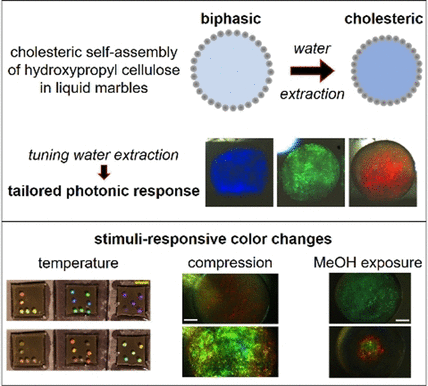Aug 31 2020
Structural colors are displayed by a surface when minuscule, regular structural elements contained in a transparent material reflect light.

Image Credit: © Wiley-VCH, Angewandte Chemie.
Now, a group of scientists has devised a new technique to create structural colors from cellulose-based polymers. The technique involves the use of coated droplets that occur in a surrounding fluid—known as liquid marbles.
The new system tends to readily respond to changes in the environment, thus making it intriguing for applications in soft photonic elements and bio-based sensors, reports the study published in the Angewandte Chemie journal.
Structural colors are a unique way of colorizing a material without the need for using a dye. By contrast, the transparent material produces color by the uniform arrangement of its molecules or other elements, as observed, for example, in the ripples in the scales of colorful fish and butterflies, or in nanocrystals distributed at specific distances, for instance, in the color-changing skin of chameleons.
Manos Anyfantakis and the team from the University of Luxembourg have found a technique to manipulate the pitch, the distance of a full helical turn in a polymer, as a structural element on which reflection might take place and structural colors emerge.
Researchers can develop liquid crystalline phases of biopolymers with pitches that produce structural colors—known as cholesteric phases. However, these preparations are based on several parameters and require a long time to attain equilibrium.
Most recently, Anyfantakis and the team identified a faster, improved controllable method, which involves the use of liquid marbles as a platform to achieve the controlled self-assembly of biopolymer-based structural colors.
Liquid marbles are droplets of liquid crystalline solutions ranging a few millimeters in size and coated with nanoparticles. The coating prevents the liquid from combining with the outer fluid. However, it still enables interaction to a certain extent, based on the nature of both the liquids.
For this study, the researchers developed liquid marbles using an aqueous solution of hydroxypropyl cellulose—a modified cellulose polymer that adapts itself in cholesteric phases—coated with silica nanoparticles.
Initially, these cellulose-based liquid marbles were colorless. However, when they were allowed to stay in a preset volume of an organic solvent for some time, bright colors of red, blue, and green emerged slowly.
The colors were caused by a change in the concentration of the droplets, discovered the researchers. The organic solvent gradually absorbed water from the liquid marbles, thereby making the biopolymer to take up a crystal form, which is ideal for structural colors.
The researchers noted that controllability and slowness were crucial since, “this gives enough time for the polymer molecules to adjust to the concentration change, organizing with a new equilibrium pitch,” they described.
The new technique is simple and exquisite, and the colors are based only on the volume of the organic solvent. Moreover, the researchers introduced external stimuli like pressure, heat, or exposure to chemicals and noted the characteristic shifts in colors with respect to a variable pitch size.
These shifts were found to be reversible—when normal conditions were reapplied, the researchers noted that the liquid marbles returned to their original colors. The researchers hope that the liquid marbles based on biopolymers could pave a new way to produce eco-friendly, sustainable, and cost-effective sensors.
Journal Reference:
Anyfantakis, M., et al. (2020) Responsive Photonic Liquid Marbles. Angewandte Chemie. doi.org/10.1002/anie.202008210.